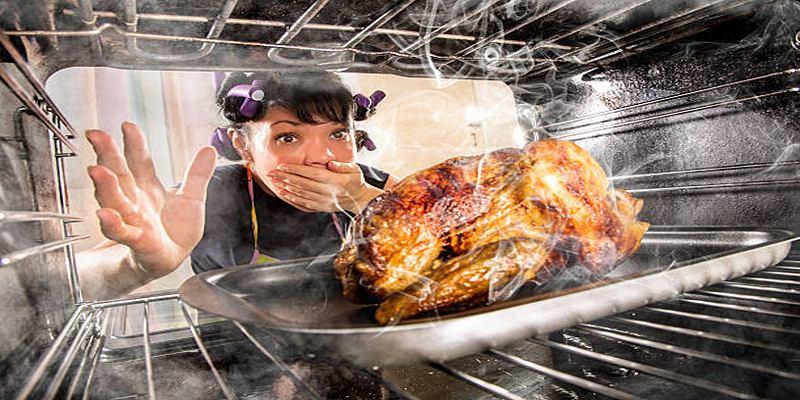Cooking chicken can sometimes seem straightforward, but many home cooks unknowingly make common mistakes that can lead to less-than-perfect results. From not preheating the pan to ignoring the size of the chicken, these errors can affect the texture, flavor, and overall quality of your dish. By understanding these pitfalls and how to avoid them, you can ensure that your chicken dishes are always juicy, flavorful, and perfectly cooked. This guide covers nine of the most frequent chicken cooking mistakes and offers practical tips to help you dodge them, resulting in deliciously prepared chicken every time.
Not Preheating the Pan
Cooking chicken without preheating the pan is a frequent mistake that can drastically affect your dish's outcome. A properly preheated pan ensures a golden, crispy crust while locking in the natural juices, resulting in moist and flavorful chicken. To avoid this, give your pan a few minutes to heat up over medium-high heat before adding your chicken.

When you place too many pieces of chicken in the pan, it reduces the temperature of the cooking surface significantly. This leads to steaming instead of searing, resulting in chicken that's pale and lacks that desirable crispy texture. Overcrowding also means the chicken cooks unevenly, which can be a food safety concern. To avoid this, cook your chicken in batches if necessary. Ensure there's enough space for each piece to have direct contact with the pan. This simple step ensures even cooking and gives each piece the chance to develop a beautiful, golden-brown crust. Additionally, using a larger pan or even a griddle can help accommodate more pieces without compromising quality.
Using Cold Chicken
Using cold chicken right from the refrigerator is a mistake that can lead to uneven cooking. When the chicken is too cold, the exterior may cook quickly, while the interior remains undercooked. This not only affects the taste and texture but is also a food safety concern. To avoid this issue, allow the chicken to sit at room temperature for about 20-30 minutes before cooking. This brief resting period helps to ensure that the chicken cooks more evenly, resulting in a juicier, perfectly cooked dish. Remember, patience is key; giving your chicken a little time to warm up can make a significant difference in the final outcome. Proper preparation sets the foundation for a delicious meal, so take this small but crucial step for the best results.
Skipping the Seasoning
Skipping the seasoning is another common mistake that can lead to bland chicken. Seasoning is crucial for enhancing the flavor of your dish and should not be overlooked. Salt is the most essential seasoning, as it intensifies the natural flavors of the chicken and helps retain moisture. However, don't stop at just salt; incorporating other herbs and spices like garlic powder, paprika, rosemary, or thyme can elevate your dish to new heights. For best results, season the chicken generously and evenly on all sides before cooking. If possible, let it sit for a few minutes to allow the flavors to penetrate. This extra step ensures your chicken is flavorful and aromatic, making for a far more enjoyable dining experience.
Cooking at the Wrong Temperature
Cooking chicken at the wrong temperature is a common blunder that can turn a potentially delicious dish into a disappointing one. When cooked at a temperature that's too high, the chicken's exterior may burn while the inside remains undercooked. Conversely, if the temperature is too low, the chicken can become dry and lose its appeal. The optimal temperature for cooking chicken is medium-high, allowing for an even, golden-brown crust and fully cooked, juicy meat. Using a meat thermometer can be very helpful; the internal temperature should reach 165F (75C) for safe consumption. Adjusting the heat as needed and monitoring the temperature ensures that your chicken is cooked to perfection, ultimately enhancing both flavor and texture.
Forgetting to Rest the Chicken
Resting the chicken after cooking is a crucial step that many home cooks often overlook. Cutting into chicken immediately after cooking allows the juices to run out, leaving the meat dry and less flavorful. Allowing the chicken to rest for about 5 to 10 minutes ensures that the juices redistribute throughout the meat, resulting in a juicier and more tender dish. This waiting period also makes the chicken easier to carve and serve. To rest the chicken, simply transfer it to a plate and cover it loosely with aluminum foil. This will keep it warm while it rests. By incorporating this simple step into your cooking routine, you can significantly enhance the overall texture and taste of your chicken dishes.
Not Using a Meat Thermometer
Not using a meat thermometer is a common error that can lead to undercooked or overcooked chicken. A meat thermometer takes the guesswork out of cooking and ensures that your chicken reaches the proper internal temperature of 165F (75C). This guarantees that the chicken is safe to eat and perfectly cooked. To use a meat thermometer effectively, insert it into the thickest part of the chicken, avoiding bones, as they can give a false reading. Knowing the exact temperature helps you avoid dry, overcooked chicken or the risks associated with undercooked meat. By making this small investment, you can achieve consistently delicious and safe chicken dishes every time you cook.
Cutting Too Early
Cutting into the chicken too early is an easy mistake that can ruin an otherwise perfect dish. When you carve the chicken immediately after cooking, the juices aren't given a chance to redistribe through the meat, resulting in a drier texture. It's crucial to let the chicken rest for around 5 to 10 minutes before slicing to ensure those juices are reabsorbed, making each bite moist and flavorful. Use this resting period to prepare any side dishes or garnishes. Once rested, use a sharp knife to slice the chicken, since a dull knife can tear the meat, further compromising its texture. Patience in this final step yields a succulent and satisfying chicken dish.
Ignoring the Chicken's Size
Larger pieces of chicken require a different cooking approach compared to smaller ones. Ignoring this fact often leads to unevenly cooked meat. Larger pieces, such as whole chickens or thick chicken breasts, take longer to cook and are more prone to being undercooked in the center if not properly managed. To tackle this, consider spatchcocking a whole chicken, which allows it to cook more evenly. For thick breasts, slice them horizontally to create thinner cutlets or use a meat mallet to pound them to an even thickness. This ensures the chicken cooks thoroughly without drying out. Always check the internal temperature to make sure it's reached 165F (75C), ensuring your meal is both safe and delectable.
Tips to Dodge Overcooking Chicken
Overcooking chicken is a common pitfall that can turn a potentially delicious meal into a tough, dry disappointment. Fortunately, there are several strategies you can employ to avoid this issue and ensure your chicken remains succulent and flavorful.
- Monitor Cooking Time: Keeping a close eye on the cooking time is essential. Chicken can overcook quickly, especially breasts, which are leaner and have less fat to keep them moist.
- Use a Meat Thermometer: Always use a meat thermometer to check the internal temperature. The chicken is perfectly cooked at 165F (75C). This prevents you from overcooking it while ensuring it's safe to eat.
- Brine the Chicken: Brining the chicken before cooking can help it retain moisture, adding flavour and tenderness. A simple brine can be made with water, salt, and sugar.
- Cook Evenly Sized Pieces: Ensure all chicken pieces are of similar size to promote even cooking. If pieces are of different sizes, the smaller ones should be removed earlier.
- Rest After Cooking: Allow the chicken to rest for 5 to 10 minutes after cooking. This lets the juices redistribute, making the meat moister and more flavourful.
- Maintain Proper Heat Levels: Cook on medium-high heat to sear the chicken and lock in juices, but ensure not to burn the exterior while the inside is still cooking.
Conclusion
Mastering the art of cooking chicken involves attention to detail and avoiding common pitfalls. By allowing the chicken to come to room temperature before cooking, seasoning it generously, cooking at the correct temperature, using a meat thermometer, and resting the chicken after cooking, you can ensure that your dish is both safe and delicious. Additionally, considering the size of the chicken pieces and adjusting your cooking methods accordingly can make a significant difference. Incorporating these tips into your cooking routine will help you consistently achieve perfectly cooked, flavorful, and juicy chicken dishes, elevating your culinary skills and dining experience.







